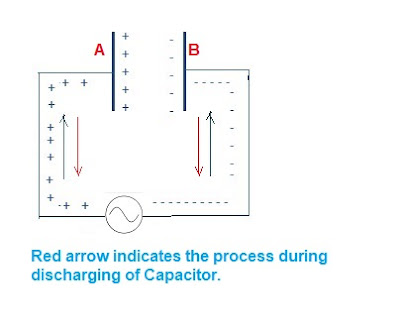All of us know that a Capacitor do not allow DC current to pass through it but allows AC current. In this post we will discuss this kind of behavior of Capacitor.First we will consider DC supply connected to a parallel plate capacitor as shown in figure below.
Let the capacitance be C. So as we connect the one of parallel plate capacitor to the positive terminal of battery and another plate to the negative terminal of battery, a potential difference exists.
Here in our case, the potential difference between plate A of capacitor and positive terminal of battery = 5 V. Because of this potential difference, positive charge will start moving from the positive terminal of battery to the plate A of capacitor. Mind that charge is not supplied by the battery rather is the mobile electron of the connecting wire. Thus, the charge on the Plate A of Capacitor will be increasing from zero value to some finite value till the potential of plate A becomes equal to the potential of positive terminal of the battery. After this no further movement of charge will occur from positive terminal of battery to the plate A. Thus we can say at steady state, potential of plate A = 5 V and no further movement of charge i.e. no current.
But note that DC current is flowing through the capacitor till the transient state lasts i.e. till the time the potential difference between the plates of capacitor and battery becomes zero.
Thus we observe that in steady state, there is no potential difference between the plates of capacitor and the battery terminals to drive current. That is why a Capacitor is said to Block the DC current.
How Capacitor Allows AC?
Consider a parallel plate Capacitor connected with an alternating Voltage Source as shown in figure.
When AC voltage is applied across the plates of parallel plate capacitor, plate A will start to get charge till VPK and plate B of capacitor will get negative charge. But after peak voltage VPK, as the voltage of source is less than the voltage across the capacitor plates, the capacitor will start discharging till source voltage becomes zero. After that as the source voltage is going negative, the Plate A will now become negatively charged while plate B will be positively charged till negative peak of source voltage but once negative peak of applied voltage crosses, the capacitor will again start to discharge as the potential difference across the plates of capacitor is more than the source voltage. In this way Capacitor continuously charge and discharge for applied AC and hence we say Capacitor is allowing AC to flow.
Mind that when the applied voltage is at its peak, the capacitor is fully charged and therefore no movement of charge will take place at this instant and hence current through the capacitor is zero when the applied voltage is its peak. Similarly, when the applied voltage is zero, the capacitor is fully discharged and therefore as the voltage increases just from its zero voltage, charging current will start flowing from source to the plates of capacitor but as the charge gets accumulated on the plate, the potential of plate rises resulting in decrease in potential difference between the plates and the source. Because of this the magnitude of charging current decreases and becomes zero when the potential of plates of capacitor becomes equal to the source potential. This is why, we say Capacitor takes leading current.
Have Question? Please write in comment box. Thank you!



State why capacitor does block dc clearly and in short
Because the potential difference between the plates of capacitor and dc source becomes zero in steady state. This is the reason, capacitor blocks DC. Did you understand? Please revert for more clarification.